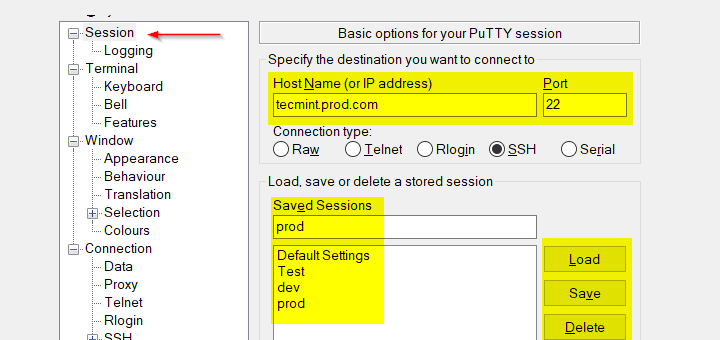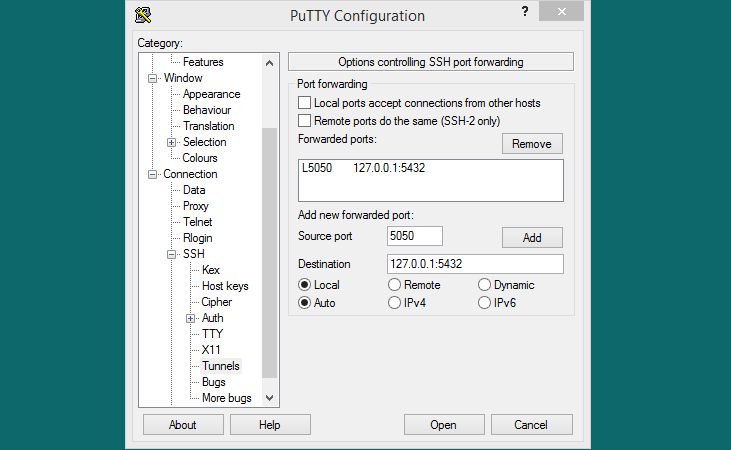PuTTY is an easy-to-use telnet and SSH program for Windows developed by Simon Tatham. Translate tab. CUIT recommends PuTTY for connecting to the UNIX servers and other telnet/SSH hosts over the internet. Mar 18, 2021 PuTTY is a free implementation of Telnet and SSH for Windows and Unix platforms, along with an xterm terminal emulator. PuTTY is a client program for the SSH, Telnet and Rlogin network protocols.
- Remote Server Connection. To connect to any remote servers via SSH we will use either IP address.
- Atlas Putty provides contract manufacturing services for companies that wish to outsource all or some of their own production. We serve the Industrial, Commercial and Consumer markets and can manufacture and package to strict specifications, customize formulae or assist with formula development.
| Developer(s) | Simon Tatham |
|---|---|
| Stable release | 0.72 / July 20, 2019 |
| Repository | |
| Written in | C |
| Operating system | Cross-platform |
| Type | Terminal emulator |
| License | MIT License |
| Website | Project home page |
PuTTY is a terminal emulatorapplication which can act as a client for the SSH, Telnet, rlogin, and raw TCPcomputing protocols. The word 'PuTTY' has no meaning,[1] though 'tty' is sometimes used to refer to the Unix terminals, as an acronym for 'teletype'.
PuTTY was first written for Microsoft Windows, but it has been ported to other operating systems including some Unix-likeplatforms. Mac OS and Mac OS X are still being ported, while unofficial ports have been ported it to the Symbian and Windows Mobileoperating systems.

PuTTY is currently beta software. Spooked. Licensed under the MIT License, and it is free and open source software.
Putty Ssh
Features[change | change source]
Some features of PuTTY are:

- Unicode support.
- Control over the SSH encryption key and protocol version.
- Command-line SCP and SFTP clients, called 'pscp' and 'psftp' respectively.
- Control over port forwarding with SSH (local, remote or dynamic port forwarding), including built-in handling of X11 forwarding.
- Emulates most xterm, VT102 control sequences, as well as much of ECMA-48terminal emulation.
- IP Version 6 support.
- Supports 3DES, AES, Arcfour, Blowfish, DES.
- Public-keyauthentication support.
- Support for local serial port connections.
Main Programs[change | change source]
Putty Knife
The versions available are made up of some or all of the following programs:
- PuTTY - the Telnet and SSH client itself;
- PSCP - an SCP client, i.e. command-line secure file copy;
- PSFTP - an SFTP client, i.e. general file transfer sessions much like FTP;
- PuTTYtel - a Telnet-only client;
- Plink - a command-line interface to the PuTTY back ends;
- Pageant - an SSH authentication agent for PuTTY, PSCP and Plink;
- PuTTYgen - an RSA and DSA key generation utility;
- pterm - a standalone terminal emulator.
Related pages[change | change source]
- FreeOTFE - Disk encryption
- Pretty Good Privacy (PGP) - Email encryption
References[change | change source]

- ↑'PuTTY FAQ'.
[PuTTY is] the name of a popular SSH and Telnet client. Any other meaning is in the eye of the beholder. It's been rumoured that ‘PuTTY' is the antonym of ‘getty', or that it's the stuff that makes your Windows useful, or that it's a kind of plutonium Teletype. We couldn't possibly comment on such allegations.
Other websites[change | change source]
| Wikimedia Commons has media related to PuTTY. |
- Development libraries related to PuTTY
- W-PuTTY-CD, PuTTY Communications in a Microsoft Windows™ DLLArchived 2019-08-19 at the Wayback Machine
- Other versions of PuTTY (for Windows):
- QuestPuttyArchived 2019-04-21 at the Wayback Machine
- Other programs related to PuTTY
- PuTTY Connection Manager[permanent dead link]
Overview
Often you do not have direct access to a desired server, because a firewall blocks the port or you are on another network than the server. But eventually you may have access to a proxy server, from which you can access the desired server. For example you would like to access an Oracle database on 192.168.151.2 on port 1521 with you local SQL tools and you don't want to do it from the proxy server. With SSH port forwarding you can establish a logical connection through the proxy an you will then be able to access the Oracle database through it.
You can use the very common SSH client PUTTY to establish this logical connection
Port Forwarding using SSH

PuTTY is currently beta software. Spooked. Licensed under the MIT License, and it is free and open source software.
Putty Ssh
Features[change | change source]
Some features of PuTTY are:
- Unicode support.
- Control over the SSH encryption key and protocol version.
- Command-line SCP and SFTP clients, called 'pscp' and 'psftp' respectively.
- Control over port forwarding with SSH (local, remote or dynamic port forwarding), including built-in handling of X11 forwarding.
- Emulates most xterm, VT102 control sequences, as well as much of ECMA-48terminal emulation.
- IP Version 6 support.
- Supports 3DES, AES, Arcfour, Blowfish, DES.
- Public-keyauthentication support.
- Support for local serial port connections.
Main Programs[change | change source]
Putty Knife
The versions available are made up of some or all of the following programs:
- PuTTY - the Telnet and SSH client itself;
- PSCP - an SCP client, i.e. command-line secure file copy;
- PSFTP - an SFTP client, i.e. general file transfer sessions much like FTP;
- PuTTYtel - a Telnet-only client;
- Plink - a command-line interface to the PuTTY back ends;
- Pageant - an SSH authentication agent for PuTTY, PSCP and Plink;
- PuTTYgen - an RSA and DSA key generation utility;
- pterm - a standalone terminal emulator.
Related pages[change | change source]
- FreeOTFE - Disk encryption
- Pretty Good Privacy (PGP) - Email encryption
References[change | change source]
- ↑'PuTTY FAQ'.
[PuTTY is] the name of a popular SSH and Telnet client. Any other meaning is in the eye of the beholder. It's been rumoured that ‘PuTTY' is the antonym of ‘getty', or that it's the stuff that makes your Windows useful, or that it's a kind of plutonium Teletype. We couldn't possibly comment on such allegations.
Other websites[change | change source]
| Wikimedia Commons has media related to PuTTY. |
- Development libraries related to PuTTY
- W-PuTTY-CD, PuTTY Communications in a Microsoft Windows™ DLLArchived 2019-08-19 at the Wayback Machine
- Other versions of PuTTY (for Windows):
- QuestPuttyArchived 2019-04-21 at the Wayback Machine
- Other programs related to PuTTY
- PuTTY Connection Manager[permanent dead link]
Overview
Often you do not have direct access to a desired server, because a firewall blocks the port or you are on another network than the server. But eventually you may have access to a proxy server, from which you can access the desired server. For example you would like to access an Oracle database on 192.168.151.2 on port 1521 with you local SQL tools and you don't want to do it from the proxy server. With SSH port forwarding you can establish a logical connection through the proxy an you will then be able to access the Oracle database through it.
You can use the very common SSH client PUTTY to establish this logical connection
Port Forwarding using SSH
In order to use port forwarding to connect from your local machine to a port on a remote server, you need to:
Choose a port number on your local machine (e.g. 5500) where PuTTY should listen for incoming connections.
Now, before you start your SSH connection, go to the PuTTY Tunnels panel. Make sure the «Local» radio button is set. Enter the local port (e.g. 5500) number into the «Source port» box. Enter the destination host name and port number into the «Destination» box, separated by a colon (e.g. 192.168.151.2:1521).
Now click the [Add] button. The details of your port forwarding should appear in the list box.
Now start your session and log in to the proxy host. To check that PuTTY has set up the port forwarding correctly, you can look at the PuTTY Event Log.
Now if you connect to the source port number on your local PC, you should find that it answers you exactly as if it were the service running on the destination machine.
You can also forward ports in the other direction: arrange for a particular port number on the server machine to be forwarded back to your PC as a connection to a service on your PC or near it. To do this, just select the «Remote» radio button instead of the «Local» one. The «Source port» box will now specify a port number on the server.
Enter Source and Destination, then click Add Button
After clicking the Add Button
X11 Forwarding
If you need to start a graphical application from the database server (on 192.168.151.2) and the output should be displayed on your local PC, then you must activate X11 forwarding in PUTTY.
Putty Download
Now log in to the SSH proxy server as normal. To check that X forwarding has been successfully negotiated during connection startup, you can check the PuTTY Event Log. Gobdokumente.
Putty For Mac
From the proxy server you must now enable X11 forwarding to the DB server, this can be established with the -X option of ssh.
Putty 64 Bit Download For Windows 10
proxy> ssh -X oracle@192.168.151.2
Putty Telnet Ssh
Now you can start for example Oracle's runInstaller and the output is displayed on your local PC - do not forget to start the cygwin X11 server on the PC.

